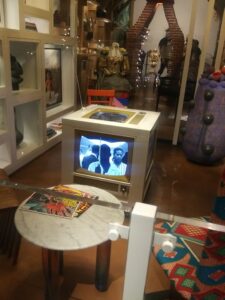EMILY ZALDUMBIDE, ARIANNA REYES, SABLE GRAVESANDY, and BRENIKA BANKS
MEETING BEYONCE AT THE MET AND MARTIN LUTHER KING JR. IN A CUPThe Afrofuturism room displays African diasporic culture, reconciling it with a variety of eras from Victorian to modern to futuristic. Cultural Black figures such as Beyonce, Jean-Michel Basquiat and Zora Neale Hurston are prominently featured on plates and cups and other household items. By featuring these items in a house, these items of Blackness take on a more personal and intimate feel. It should be noted that the house is placed in a very constricted spot in the museum, symbolizing how Blackness is often confined by European colonizers and their definitions of cultural validity. However, despite the small space, the house is filled with indicators of wealth. The bodice dress, crystal case and fine china display a house of wealth, symbolizing that future Black households have and always will be places of cultural and monetary wealth.


 Upon visiting the Afrofuturism room, we came across Venetian Glassware that felt out of place compared to the rest of the items on display in this because of how everything looked quintessentially associated as “Black”. Some of our first thoughts were “Wow, I did not expect this to be here, it looks out of place.”. I think an unconscious bias rang heavily because it is been historically normalized through western history that black people don’t usually have access to such nice things especially fancy glassware in a period where only the rich owned glassware of this manner even when poor whites couldn’t afford it.
After reading the description and learning about the journey of the glassware to be in the room it described the connection of northern Africa and Europe, in this case, Italy, understanding that Africa has always been a place of abundant raw materials for people to take from, it reminds me of people going into “black spaces” and taking what they like best from it and then calling it their own. Black people were enslaved and forced to work in difficult conditions.
Looking at the entirety of the house itself, we can see that it is missing elements like a roof or walls, and even the parts of the house uses different materials at one part of the house and another. This felt like a metaphor to Afrofuturism in itself, the housing representing its work-in-progress and the change from using wood to brick representing a sense of transformation of Afrofuturism, showing how the African diaspora was changing their ways to represent themselves in the world.
Upon visiting the Afrofuturism room, we came across Venetian Glassware that felt out of place compared to the rest of the items on display in this because of how everything looked quintessentially associated as “Black”. Some of our first thoughts were “Wow, I did not expect this to be here, it looks out of place.”. I think an unconscious bias rang heavily because it is been historically normalized through western history that black people don’t usually have access to such nice things especially fancy glassware in a period where only the rich owned glassware of this manner even when poor whites couldn’t afford it.
After reading the description and learning about the journey of the glassware to be in the room it described the connection of northern Africa and Europe, in this case, Italy, understanding that Africa has always been a place of abundant raw materials for people to take from, it reminds me of people going into “black spaces” and taking what they like best from it and then calling it their own. Black people were enslaved and forced to work in difficult conditions.
Looking at the entirety of the house itself, we can see that it is missing elements like a roof or walls, and even the parts of the house uses different materials at one part of the house and another. This felt like a metaphor to Afrofuturism in itself, the housing representing its work-in-progress and the change from using wood to brick representing a sense of transformation of Afrofuturism, showing how the African diaspora was changing their ways to represent themselves in the world.
 In the Fictions of Emancipation exhibit we were struck by the sculptures of black people shown in classical styles. These depictions help us to imagine what could have been in a world without slavery, or if emancipation had been achieved earlier. Also in the exhibit, Christopher and G’Nelle both took photos of the Antislavery ornaments.
In the Fictions of Emancipation exhibit we were struck by the sculptures of black people shown in classical styles. These depictions help us to imagine what could have been in a world without slavery, or if emancipation had been achieved earlier. Also in the exhibit, Christopher and G’Nelle both took photos of the Antislavery ornaments.


